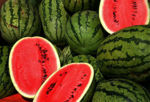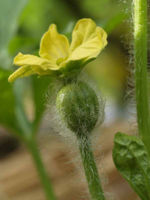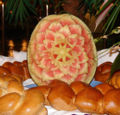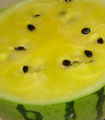Watermelon
| Watermelon |
|---|
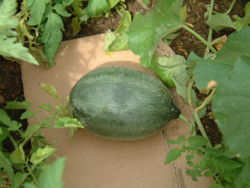
|
| Scientific Classification |
|
| Binomial Name |
|
Citrullus lanatus |
The watermelon has a reputation as being one of the most refreshing fruit in the world. It is said that over 5,000 years ago it was a custom for an Egyptian peasant to offer the watermelon as a gift to thirsty travelers. It gets its name because of its high water content of between 92% and 95%. A variety of melons are believed to be of African origin. Watermelon has been widely consumed since ancient times, particularly in Mediterranean countries and in Egypt, where it frequently played an important role when water was polluted or in short supply. (The Visual Food Encyclopedia, p263)
Anatomy
Depending on the variety, the watermelon can range from very small to very large and can weigh from a few pounds up to 90 pounds. They can range in shape and size anywhere form being round, oblong, or spherical. The skin or rind of the watermelon is thick. It can range in color from pale to dark green and is often striped or spotted. The pulp is usually red, but can also be white, yellow, or pinkish. The rind often has many smooth seeds ranging in color from black to brown, white, green, yellow, or red. However, there are a few varieties of watermelon that have no seeds at all. The flesh of the watermelon as compared to other melons is more crisp and more thirst-quenching because of its high water content. It is well known that people eat the watermelon as a fresh fruit. But it is not well known that people also eat the seeds, pickle the rind to make relish, and use the fruit in syrup and even cattle feed. Even though the watermelon has a high level of water, it provides a good source of vitamins A and C and of lycopene. Lycopene is a chemical that may help reduce the risk of cancer and may help prevent blindness. (The World Book Encyclopedia p146)
Reproduction
Watermelons grow on vines and require a long growing season. They mature in about 75 to 100 days. Commercial farmers usually plant the seeds about 4 feet apart in rows spaced about 6 to 8 feet from one another. During cold weather, the seeds are often planted in a greenhouse first. They are then transplanted into fields after the danger of frost has passed. Watermelon farmers must also transplant all seedless cultivars. The tendrils attach themselves to objects in the field. The watermelon fruit must be pollinated in order to develop. The watermelon is an annual plant. The vines or runners with their large green lobed leaves can grow up to 40 feet long or more. They produce slender, coiling tendrils and yellow blossoms and a round or oblong, green or cream striped or mottled fruits. When a watermelon ripens, the rind color becomes dull and the top of the fruit flattens slightly. Ripe watermelons make a dull, hollow thud when thumped. (The American Horticultural Society A-Z Encyclopedia of Garden Plants p272)
Ecology
Like all melons, watermelons are the fruits of an annual plants that require a warm climate. In fact, the warmer the climate the better. The exception are the more than 50 varieties of hybrids that grow in temperate zones. It is believed that the watermelon plant originated in western or southern Africa. China has cultivated the fruit for more than 1,000 years, and ranks as one of the top watermelon-producing country in the world. Other major producers include Turkey, Iran, and the United States. (The Visual Food Encyclopedia, p263)
Gallery
 Browse |
Related References
- The Visual Food Encyclopedia. "Watermelon Citullus lanatus, Cucurbitaceae." New York: Wiley Publishing, 1996
- The World Book Encyclopedia. "Watermelon." Chicago: Scott Fetzer Co., 2007
- The American Horticultural Society A-Z Encyclopedia of Garden Plants. "Cirtullus." New York: DK Publishing, 1996
